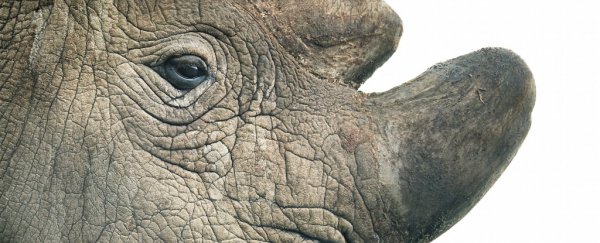Unable to stand, and suffering from a string of infections in his advanced age, the world's last male northern white rhino was euthanized Monday by a veterinary team in Kenya that had fought for years to save him and his dwindling species.
Only two now remain - his daughter, Najin, and granddaughter, Fatu - leaving in-vitro fertilization from preserved sperm as the last tool against extinction.
Sudan, who was 45 when he died, had unsuccessfully tried to mate with females from a related sub-species of rhino found in southern Africa.
The second-to-last male, Suni, died in 2014, possibly from a heart attack. Both Sudan and Suni were likely too old to be fertile by the time they were brought to the Ol Pejeta Conservancy in Kenya from a zoo in the Czech Republic in 2009.
"We at Ol Pejeta are all saddened by Sudan's death. He was an amazing rhino, a great ambassador for his species, and will be remembered for the work he did to raise awareness globally of the plight facing not only rhinos, but also the many thousands of other species facing extinction as a result of unsustainable human activity," Ol Pejeta Conservancy CEO Richard Vigne said in a statement.
"One day, his demise will hopefully be seen as a seminal moment for conservationists worldwide."
Sudan's death comes as other rhino populations around the world teeter on the brink of extinction, largely due to poaching.
Rhino horn has been highly prized in Chinese traditional medicine and as a decorative component of daggers carried by many Yemeni men.
Around 30,000 rhinos from five species remain worldwide. Two species in Indonesia, the Sumatran and Javan rhinos, have around or less than 100 individuals.
A recent drop in the price of rhino horn did not come soon enough to save the northern white rhino from near-certain extinction.
A 2016 study published in Swara magazine found that wholesale rhino horn prices had decreased in both China and Vietnam US$65,000 per kilogram in 2012-13 to US$30,000 to $35,000 per kilogram in 2015.
Al Jazeera found that the price in China declined even further during 2016 to fewer than US$29,000 per kilogram.
Still, South Africa, home to the biggest population of rhinos in the world, has lost about 1,000 per year to poaching since 2013, according to WildAid.
Sudan was born in 1972 in what is now South Sudan at a time when there were still around 1,000 northern white rhinos roaming wild. But their habitat was then, as it remains today, one riven by human conflict.
As my colleague Kevin Sieff wrote in a profile of Sudan in 2015, "They were concentrated in countries plagued by war: Sudan, Congo, the Central African Republic. When fighting broke out, the rhinos were also victims, killed for their meat or their horns, or sometimes exchanged for money or arms."
But Sudan was saved from the grisly fate of other northern whites by representatives from Dvur Králové Zoo in the Czech Republic.
At that time, when Sudan was just 3 years old, the extinction of his species did not seem imminent. Conservationists believed that interventions in which more northern whites were extracted from conflict-prone environments would stem their decline.
Instead, both conflict and poaching surged during the next few decades, and northern white rhinos paid the price. By 2003, there were thought to be only 20 left in the wild, all in Congo's Garamba National Park.
The Congolese government blocked plans to take any of them out of the country, and within a few years all of them had been killed.
Sudan spent the last years of his life under 24-hour protection from armed guards. His horn had been chopped off to deter poachers, though it had begun to grow back. His guards regularly foiled poaching attacks.
But the effort to save the northern white rhino seems to have come too late for a real turnaround.
Ol Pejeta Conservancy estimates that the cost of in-vitro fertilization - from development of the method, to trials, implantation and the creation of a viable breeding herd of northern whites - could be as much as $9 million.
In a press release, the conservancy said it is attempting an unprecedented intervention "to try and conduct the first-ever procedure to safely remove egg cells from remaining females, fertilize these with semen previously collected from northern white males, and insert the resulting embryos into female southern white rhinos acting as surrogates."
"Sudan was the last northern white rhino that was born in the wild. His death is a cruel symbol of human disregard for nature and it saddened everyone who knew him," said Jan Stejskal, director of international projects at the Dvur Králové Zoo.
"But we should not give up. We must take advantage of the unique situation in which cellular technologies are utilized for conservation of critically endangered species. It may sound unbelievable, but thanks to the newly developed techniques even Sudan could still have an offspring."
2018 © The Washington Post
This article was originally published by The Washington Post.
